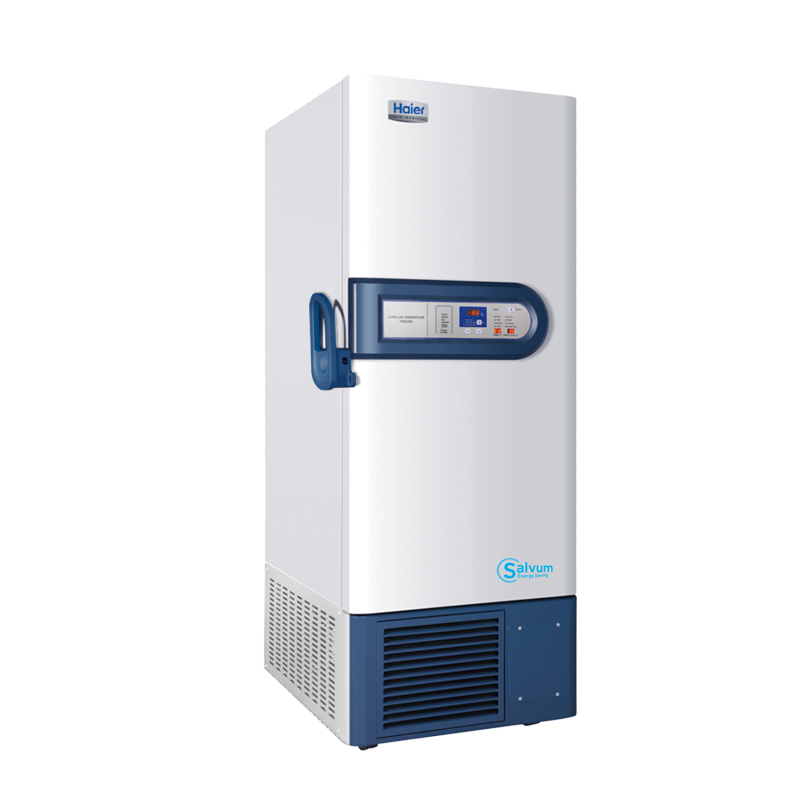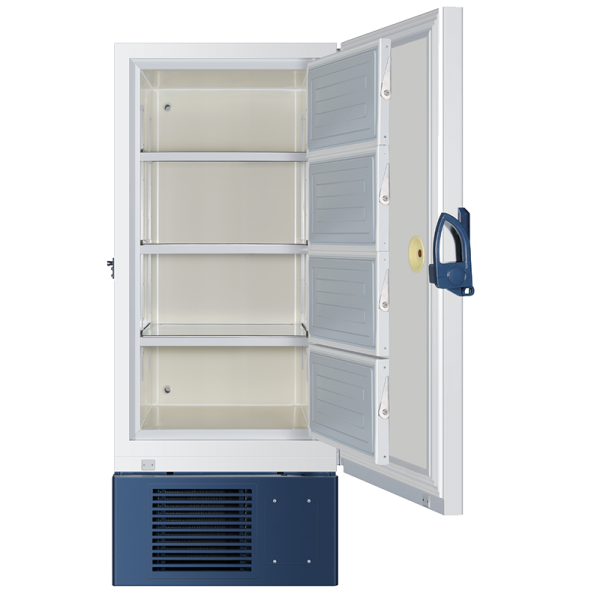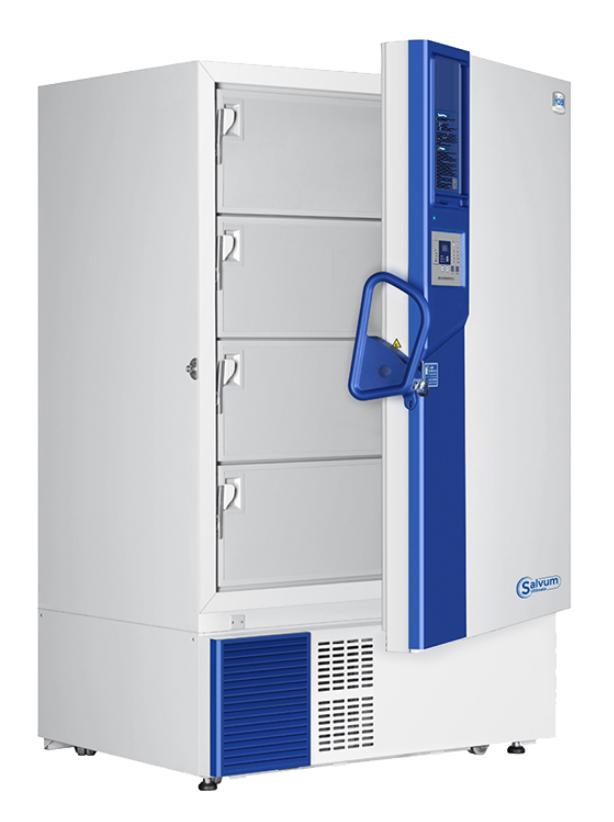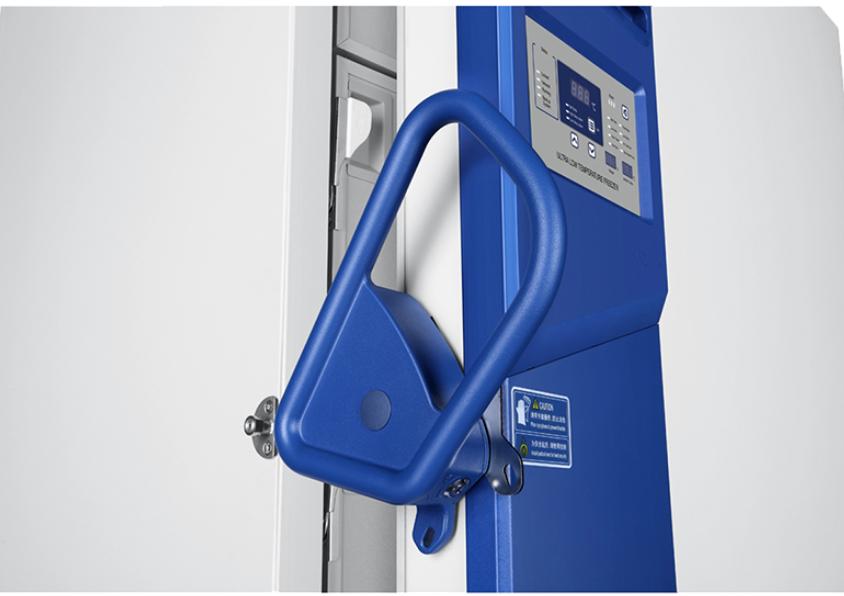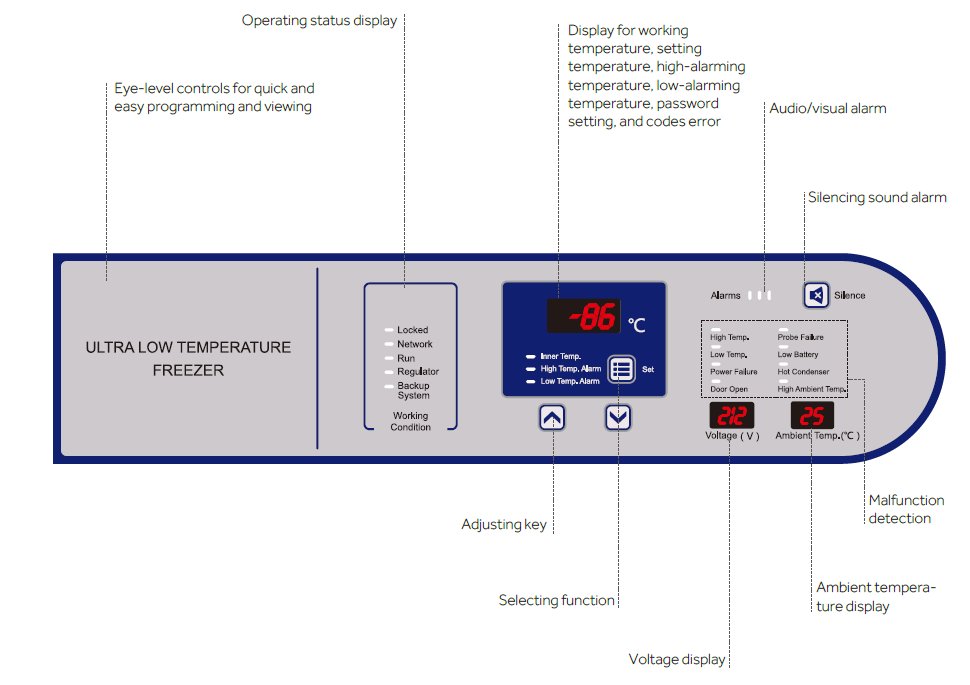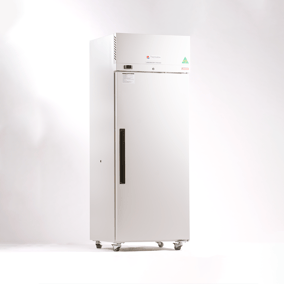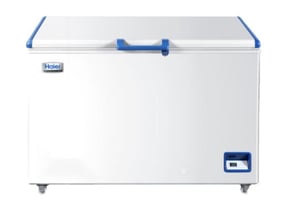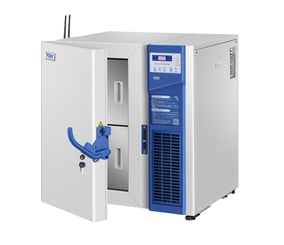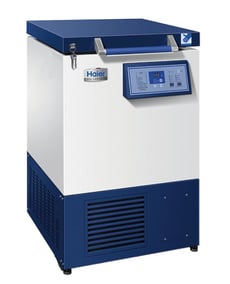-80°C Ultra Low Temp Upright Freezer DW-86L
Haier's third-generation ULT freezers are designed with technology that improves energy efficiency. The TwinCool technology provide optimal reliability, longevity, efficiency, and sample protection.
Two independent refrigeration systems ensure samples are fully protected under worst-case conditions, depending on load demands and ambient conditions. Additionally, each system is capable of maintaining -80°C separately.
Overview
Haier Biomedical's ultra-low temperature freezers feature TwinCool technology, providing optimal reliability, longevity, efficiency, and sample protection. Two independent refrigeration systems ensure samples are fully protected under worst-case conditions, depending on load demands and ambient conditions.
Key Features
- TwinCool Technology: Ensures maximum sample protection with two independent refrigeration systems.
- Fast Pulldown: The cabinet pulldown is fast and efficient, taking an average of three hours to reach -80°C at 25°C ambient. This ensures that the temperature recovers quickly after a door opening, minimising exposure of stored samples to undesirable temperatures.
- Energy Efficiency: These freezers are highly energy-efficient, consuming only 8.2 kWh/day of power.
- Low Noise Operation: The innovative refrigeration design and adaptive control technology reduce operational noise to 43.5 dB(A).
- Insulated Inner Doors: Features insulated inner doors with four separate storage compartments to minimise frost buildup and allow independent access for maximum sample protection.
- Precise Temperature Control: The microprocessor-controlled system maintains temperatures between -40°C to -86°C with 1°C increments.
- VIP Insulated Panels: Ensure efficient thermal insulation, reducing energy consumption and maintaining consistent internal temperatures.
- Advanced Security: Includes a user-settable protection code, voltage compensation system, and protection against extremely high voltages. Improved handle design with a unique key prevents access by other Haier freezer owners, with space for a padlock for extra security.
Benefits
- Enhanced Sample Protection: The TwinCool technology and insulated inner doors provide superior protection for valuable samples, even under adverse conditions.
- Operational Efficiency: Fast pulldown and recovery times minimise the exposure of samples to undesirable temperatures, ensuring they remain in optimal conditions.
- Cost Savings: The energy-efficient design and low power consumption reduce operational costs, making these freezers a cost-effective choice for laboratories.
Common Uses
- Biomedical Research: Storing biological samples such as DNA, RNA, and proteins at ultra-low temperatures to preserve their integrity for long-term studies.
- Pharmaceutical Storage: Keeping vaccines, drugs, and other pharmaceuticals at stable, ultra-low temperatures to maintain their efficacy and shelf life.
- Cryopreservation: Freezing cells, tissues, and other biological specimens for preservation in medical, veterinary, and research applications.
Additional Features
- Malfunction Alarms: Includes alarms for high and low temperatures, power outages, sensor errors, high and low voltage, clean-filter, and high ambient conditions.
- Secure Access: The improved handle design with a unique key prevents unauthorised access, with space for an additional padlock for extra security.
- Innovative Design: The specialised control system with built-in protection features ensures reliable operation under a variety of conditions.
Haier Biomedical's -86°C ultra-low temperature freezers are designed to meet the highest standards of reliability and efficiency, making them an excellent choice for laboratories where sample protection, operational efficiency, and cost savings are top priorities.
Specifications
- Dimensions
-
DW-86L338J DW-86L388J DW-86L490J DW-86L578J DW-86L728J DW-86L828J DW-86L959BP External WxDxH (mm) 830x893x1846 812x980x1980 860x900x1980 903x980x1960 1049x980x1980 1145x980x1980 1296x998x1980 Internal WxDxH (mm) 465x630x1165 465x716x1310 590x630x1310 620x716x1310 766x716x1310 870x716x1310 1016x716x1310 Packing WxDxH (mm) 875x970x2010 893x1078x2135 925x985x2150 950x1055x2125 1090x1050x2150 1190x1045x2150 1365x1105x2150 - Technical Specifications
-
DW-86L338J DW-86L388J DW-86L490J DW-86L578J DW-86L728J DW-86L828J DW-86L959BP Technical Data Cabinet Type Upright Upright Upright Upright Upright Upright Upright Climate Class N N N N N N N Cooling Type Direct Cooling Direct Cooling Direct Cooling Direct Cooling Direct Cooling Direct Cooling Direct Cooling Defrost Mode Manual Manual Manual Manual Manual Manual Manual Refrigerant HC HC HC HC HC HC HC Sound Level ((dB(A)) 50 50 50 50 50 50 47 Performance Cooling performance (°C) -86 -86 -86 -86 -86 -86 -86 Temperature Range (°C) -40~-86 -40~-86 -40~-86 -40~-86 -40~-86 -40~-86 -40~-86 Control Controller Microprocessor Microprocessor Microprocessor Microprocessor Microprocessor Microprocessor Microprocessor Display LED LED LED LED LED LED LED Electrical Data Power Supply (V/Hz) 220~240/50 220~240/50 220~240/50 220~240/50 220~240/50 220~240/50 208~230/50/60 Power (W) 650 650 900 750 1000 1000 1300 Electrical Current (A) 7.5 5 8 7.5 10 10 7 Capacity (L/Cu.Ft) 338/11.9 388/13.7 490/17.3 578/20.4 728/25.7 828/29.2 959/33.9 Loading Quantities Container Load (20'/40'/40'H) 12/24/24 12/24/24 12/24/24 12/24/24 12/20/20 8/20/20 8/16/16 Net/Gross Weight (kg) (approx) 238/278 255/286 295/335 300/330 345/385 380/410 450/485 - Features
-
DW-86L338J DW-86L388J DW-86L490J DW-86L578J DW-86L728J DW-86L828J DW-86L959BP Caster ✔ ✔ ✔ ✔ ✔ ✔ ✔ Foot ✔ ✔ ✔ ✔ ✔ ✔ ✔ Porthole ✔/2 ✔/2 ✔/2 ✔/2 ✔/2 ✔/2 ✔/2 Shelves/Inner doors 3/2 3/2 3/4 3/4 3/4 3/4 3/4 USB Interface ✔ ✔ ✔ ✔ ✔ ✔ ✔ Remote Alarm ✔ ✔ ✔ ✔ ✔ ✔ ✔ 5V Power Supply Port ✔ ✔ ✔ ✔ ✔ ✔ ✔ Temperature Recorder Optional Optional Optional Optional Optional Optional Optional Rs232/485 Interface Optional Optional Optional Optional Optional Optional ✔ CO2 Backup System Optional Optional Optional Optional Optional Optional Optional LN2 Backup System Optional Optional Optional Optional Optional Optional Optional - Safety
-
DW-86L338J DW-86L388J DW-86L490J DW-86L578J DW-86L728J DW-86L828J DW-86L959BP High/Low Temperature ✔ ✔ ✔ ✔ ✔ ✔ ✔ Hot Condenser ✔ ✔ ✔ ✔ ✔ ✔ ✔ Power Failure ✔ ✔ ✔ ✔ ✔ ✔ ✔ Sensor Error ✔ ✔ ✔ ✔ ✔ ✔ ✔ Low Battery ✔ ✔ ✔ ✔ ✔ ✔ ✔ High Ambient Temperature ✔ ✔ ✔ ✔ ✔ ✔ ✔ Door Ajar ✔ ✔ ✔ ✔ ✔ ✔ ✔
Downloads
Support & FAQs
At Thermoline, we strive to supply helpful customer support to ensure that you get the most out of our products. We are committed to providing whatever support our customers need, wherever they are in the world. If you can't find your solution in the below FAQs or Knowledge Base, please contact our friendly support team.
- How often should you defrost a lab freezer?
The frequency of defrosting a lab freezer depends on the model and the usage pattern. However, it is generally recommended to defrost a lab freezer at least once or twice a year to maintain its optimal performance.
A buildup of ice in the freezer can reduce its efficiency and increase the risk of freezer burn, damaging the quality of the samples stored inside. It can also increase the risk of mechanical failure, leading to costly repairs or even loss of samples.
Following the manufacturer's instructions for defrosting the freezer is important, as the process may vary depending on the model. Generally, defrosting should be done when the freezer is relatively empty, with the samples stored elsewhere temporarily. The freezer should be turned off and allowed to thaw completely before cleaning and restarting.
In addition to regular defrosting, keeping the freezer clean and well-maintained is vital to ensure its longevity and reliability.
- What different types of laboratory freezer are available?
There are several types of laboratory freezers available, including:
-
Upright freezers: These freezers have a vertical orientation and are available in a range of sizes, from under benchtop models to large capacity units that can store hundreds of samples. Upright freezers typically have several shelves, drawers or compartments for easy organisation of samples.
-
Chest freezers: Chest freezers have a horizontal orientation and are often used for storing large or bulky items. They are more energy efficient than upright freezers and can provide longer holdover times during power outages.
- Biomedical Chest Freezers: These -60°C chest freezers are suitable for storing a wide variety of biological products including viruses, bacteria, blood cells, skin and bone as well as ocean-going supplies and electronic devices.
-
Ultra-low temperature freezers: These freezers provide even lower temperatures, down to -80°C. They are often used for long-term storage of biological specimens, vaccines, and other critical materials.
-
- What is an ultra low freezer?
- These are freezers designed specifically for laboratories to preserve biological samples. These provide a stable temperature from -40C right down to -80C
- How does an ultra low freezer work?
Ultra Low Freezers make use of cascade refrigeration. A cascade refrigeration system is a type of refrigeration system that uses two or more refrigeration cycles operating at different temperature levels to achieve extremely low temperatures. It is commonly used when standard refrigeration systems cannot achieve the desired temperature range.
In a cascade refrigeration system, two or more refrigeration cycles are arranged in series, with the evaporator of one cycle serving as the condenser of the next cycle. The cycles are typically designed to operate at different temperature levels, with the coldest cycle being used to achieve the desired low temperature.
- What is the temperature range for ultra low freezer?
The temperature range for ultra-low freezers is typically between -80°C and -40°C. These freezers are designed to maintain extremely low temperatures for long-term biological and other temperature-sensitive materials storage. They are commonly used in research and clinical laboratories, biobanks, and other facilities where the storage of valuable samples and specimens is required.
Most ULTs create a consistent environment where the freezer's internal temperature remains between -70°C and -80°C.

